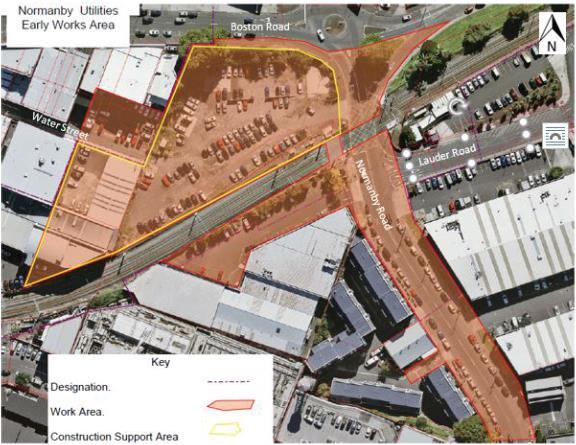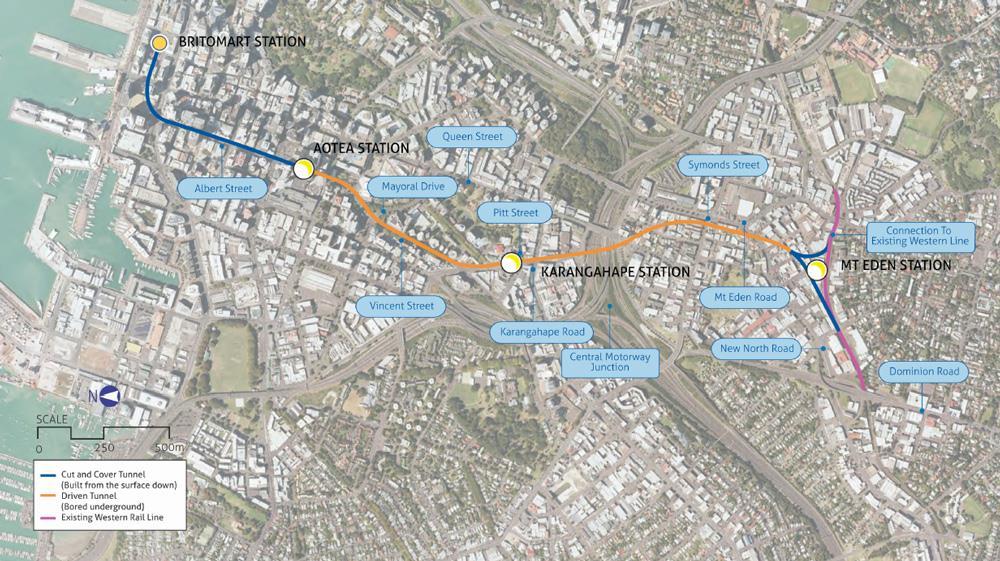
7 minute read
4. Mitigation Measures
from Trees
Groups 2 & 3
Groups 2 & 3 are identified as a row and grouping of vegetation growing in a heavily modified industrial environment. Due to hard surface constraints and available locations post works, it is considered that this vegetation is unsuitable for transplant.
Group 4
Group 4 consists of an area of wilding weed and lower value specimens, including Brush Wattle & Karamu. The trees are growing on a rocky outcrop which is proposed for clearance to enable full use of the hard stand area during construction, and to improve current passive surveillance for the safety of users of the temporary car park to be established during construction.
It is not deemed practical nor necessary to transplant these trees.
Replacement planting is proposed to mitigate the loss of the 42 trees (excluding weed species) from within the Normanby Road early works area. In addition to replacement planting, mitigation measures for works within the root zones of tree N1 and in the vicinity of T24 are proposed. These mitigation measures (as outlined in Section 4.2 below) will be implemented in order to protect trees N1 and T24 which are to be retained.
4.1 Trees Requiring Removal
Replacement planting will be undertaken as part of the public realm reinstatement on completion of construction for the CRL Mt Eden works, including works in the Normanby Road area. This will be addressed in a future Outline Plan, which will include an Urban Design Delivery Work Plan (UD DWP). Amongst other things, the UD DWP will include a replanting plan which will show the type and location of replacement trees.
The method for removal of these trees will be informed by a qualified arboricultural practitioner in accordance with site observations, such as the proximity of surrounding buildings, tree size and overall condition. The methodologies used will include the following where relevant:
Staged removal whereby the outer limbs are removed first, followed by inner limbs and the main trunk. Depending on the location of underground utility lines, tree stumps shall either be dug out or ground in situ. Removed tree debris will either be mulched onsite or removed for mulching off-site, depending on which is more practicable.
All trees (with the exception of weed species) permanently removed as part of the early works will need to be replaced to address adverse effects on private properties, amenity and local streetscape. Replanting within the property at 32 Normanby Road will be discussed and agreed upon with the land owner. If it is not possible to replant the same number of trees within the property, replacement trees will be planted in an appropriate location elsewhere within the CRL designation.
Page 12
4.2 Trees not Requiring Removal
4.2.1. Arboricultural Monitoring
Normanby Road Early Works
Trees T24 and N1 will not be removed as part of the Normanby Road early works. Arboricultural Monitoring will be undertaken to confirm these trees are adequately protected for the duration of the early works. The following information outlines measures specific to the two trees to be retained.
A suitably qualified and experienced arborist will be engaged to act as the Works Arborist for the early works.
The Works Arborist shall directly oversee and supervise any works within the root zones of those trees to be retained. The works arborist will also undertake regular Arboricultural Site Reviews (ASR) at a period of no less than once every month during any period for which works are to take place within 4 metres of the root zone of any tree(s) which will not be removed as part of the construction works. The ASR shall provide an opportunity to assess tree health of each of the trees which are to be retained, assess tree protection measures where provided, as well as providing general guidance to direct the preservation of tree health during the course of works.
The initial ASR will be undertaken at least 10 working days prior to the first commencement of work within 10 metres of any tree which is to be retained. The Works Arborist will prepare a ASR Summary Memorandum to be issued to the Environmental and Sustainability Manager (ESM) during the initial arboricultural site review, with this Memorandum to be updated by the Works Arborist following every monthly visit and provided to the ESM.
If the Works Arborist identifies evidence of declining tree health, the Works Arborist will advise on the cause of the deterioration and provide direction where appropriate.
Prior to the commencement of works on site, a pre-start meeting is to be held at least 5 working days prior to the start of any works near retained trees. The meeting is to include the Works Arborist, Councils Heritage Arborist and Community Facilities Arborist. The purpose of this meeting is to discuss the overall project and advise of those specific activities impacting retained trees on public land.
Protective fencing is to be installed at the root zone edge of those trees to be retained and protected. This fencing is to remain in place for the duration of the project where practicable. If removal or temporary relocation of protective fencing is required, this must be undertaken in consultation with the Works Arborist. The protective fencing is to consist of a minimum of 1.5 metre tall hurricane mesh style fencing or plywood hording.
There shall be no storage (or temporary storage) of any description (i.e. no products, no fluids, no machinery, no tools, etc) within the root zone of any retained tree. Special attention shall be paid to any petrol/diesel operated machinery to avoid contaminating the soil in the root zone of the trees.All equipment/vehicles shall be manoeuvred to/ within the site in a manner that avoids any damage to the root zone and canopy of the retained trees
Where machine excavation is required outside any existing hard areas (e.g. road surfaces) within the root zones of any retained tree, track movements must be kept to a minimum - with materials installed progressively from the previously metaled/hard surface.
A completion report prepared by the Works Arborist shall be supplied to the ESM within one month of completion of all site works. The completion report shall confirm (or otherwise) that the works have been undertaken in general accordance with the tree protection measures contained in this section.
Page 13
Normanby Road Early Works
4.2.2. Notable Tree Specific Protective Measures –ID N1 (Flame Tree)
Arboricultural monitoring, by the appointed early Works Arborist, will be required in order to ensure the protection of the Notable Flame tree for the duration of the early works.
As noted in Section 2 of this TV DWP, diversion of the 150mm diameter sewer line will be required. This activity will require works at the edge of the root zone of this tree.
Works within the vicinity of, or within the protected root zone of Tree N1 must be approved and supervised by the Works Arborist in accordance with Section 4.2.1 of the TV DWP.
If any significant roots are encountered during excavation in the root zone of this tree, that root should be accommodated, unless the works site supervisory arborist is satisfied that severance of such a root would not cause a deterioration of the health of the tree. Tree health will be monitored regularly during construction. Protective fencing will be erected under the supervision of the arborist as near to the edge of the tree’s root zone as possible for the duration of works. Any movement or relocation of fencing shall be discussed with the Works Arborist prior to implementation. (As per the recommendations provided in Section 4.2.1)
Figure 4-1: Notable Flame tree (N1)
4.2.3. Tree Specific Protection Measures –T24 (English Oak tree)
Tree 24 is standing on an elevated area of land within 14-22 Boston Road and overhanging Boston Road. Only minor works to re-configure the area around this Oak tree for use as a temporary carpark will be undertaken within the root zone of the tree. The site will also be used as a laydown area during construction. All works are to be undertaken in accordance with Section 4.2.1 of this TV DWP and protective fencing will be erected near the edge of the tree’s root zone.
It is noted that timber hoarding is currently installed on the tree’s northern side. Any works to be undertaken within the root zone of this tree, beyond minor works to formalise the temporarycarpark, should be assessed for impacts from an arboricultural perspective.
Page 14
Normanby Road Early Works



